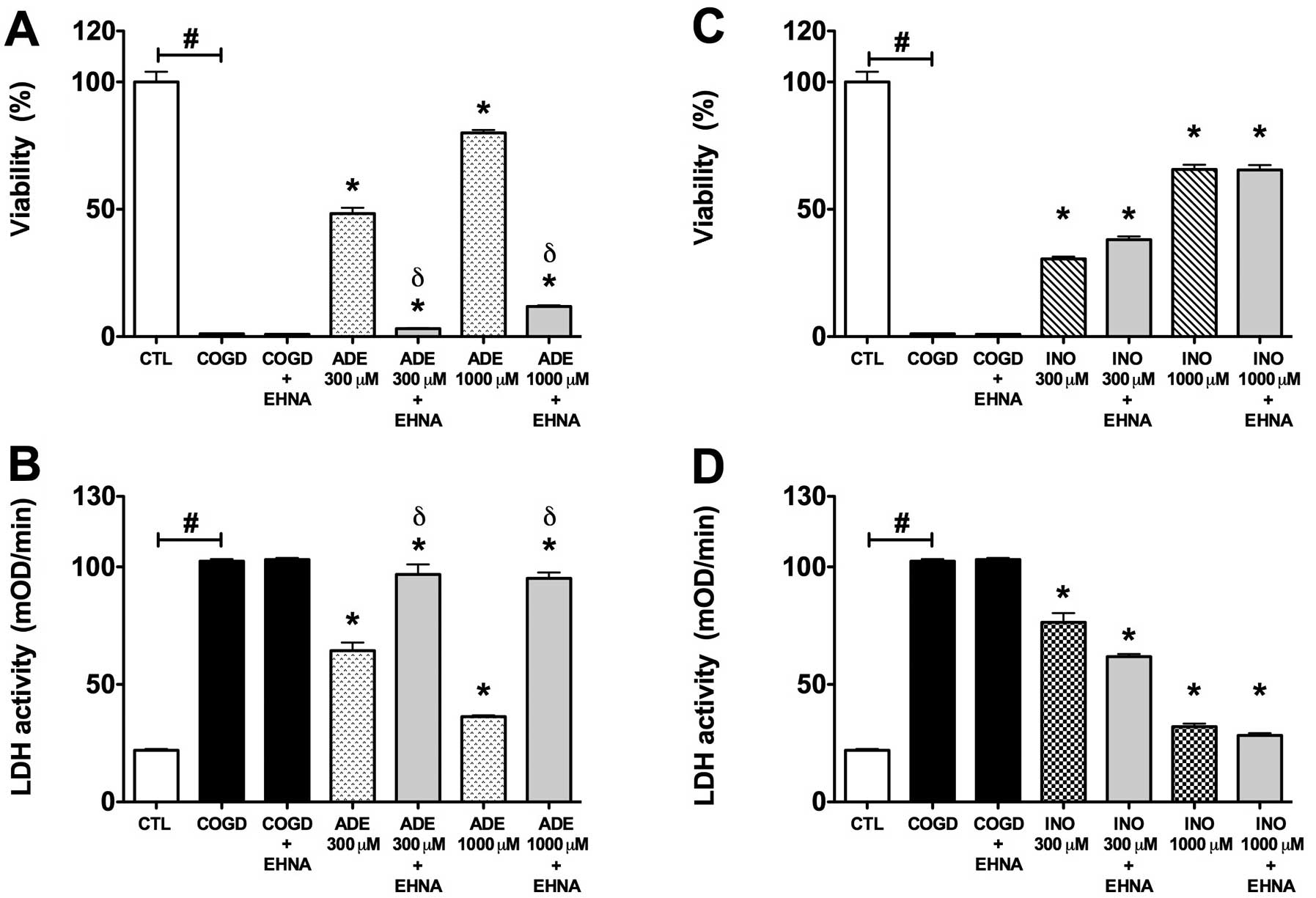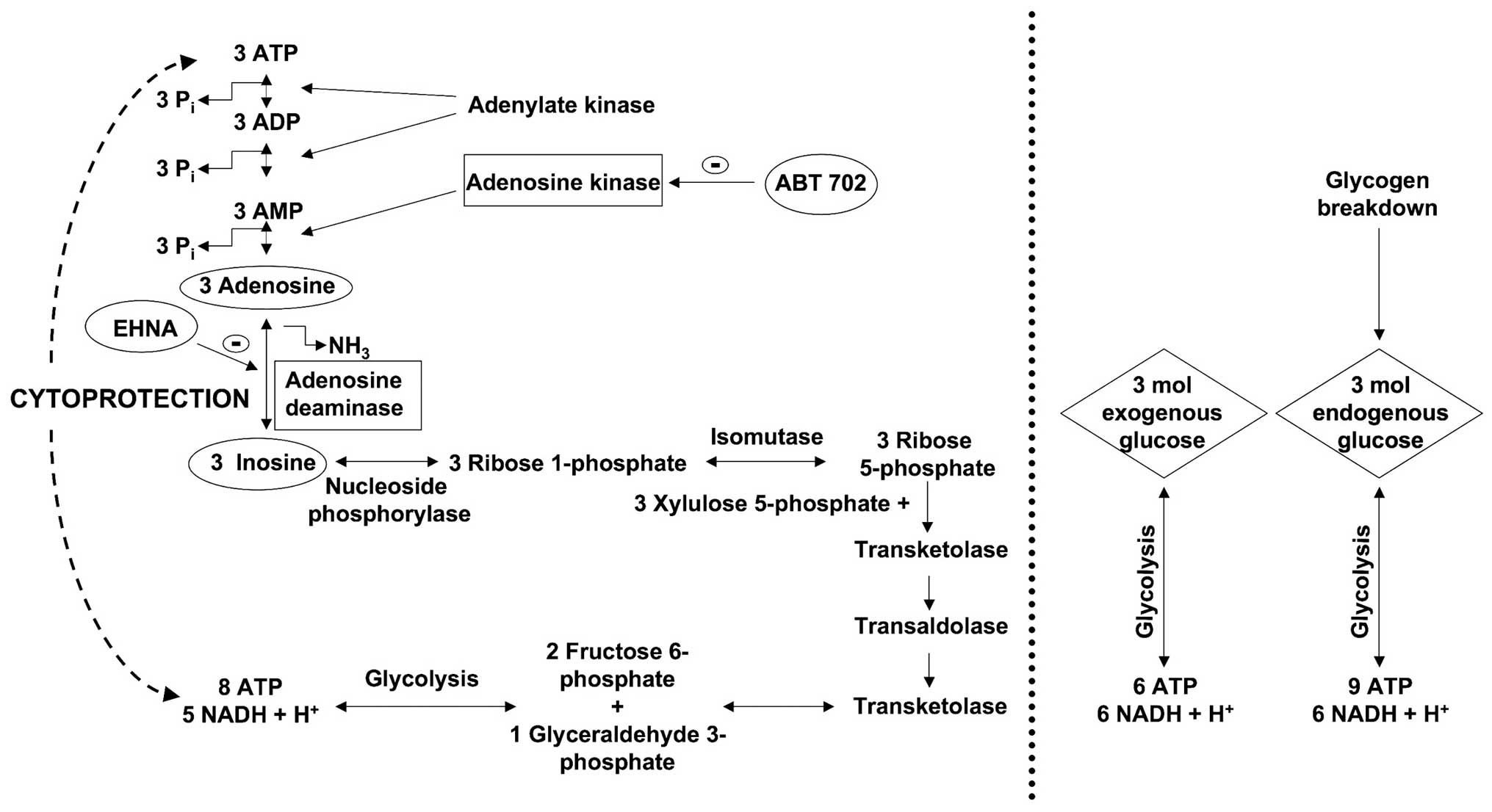|
1.
|
Carden DL and Granger DN: Pathophysiology
of ischaemia-reperfusion injury. J Pathol. 190:255–266. 2000.
View Article : Google Scholar : PubMed/NCBI
|
|
2.
|
Frangogiannis NG: Chemokines in ischemia
and reperfusion. Thromb Haemost. 97:738–747. 2007.PubMed/NCBI
|
|
3.
|
Peralta C, Bartrons R, Riera L, Manzano A,
Xaus C, Gelpi E and Rosello-Catafau J: Hepatic preconditioning
preserves energy metabolism during sustained ischemia. Am J Physiol
Gastrointest Liver Physiol. 279:G163–G171. 2000.PubMed/NCBI
|
|
4.
|
Cavalieri B, Perrelli MG, Aragno M,
Mastrocola R, Corvetti G, Durazzo M, Poli G and Cutrin JC: Ischemic
preconditioning attenuates the oxidant-dependent mechanisms of
reperfusion cell damage and death in rat liver. Liver Transpl.
8:990–999. 2002. View Article : Google Scholar : PubMed/NCBI
|
|
5.
|
Lee WY and Lee SM: Ischemic
preconditioning protects post-ischemic oxidative damage to
mitochondria in rat liver. Shock. 24:370–375. 2005. View Article : Google Scholar : PubMed/NCBI
|
|
6.
|
Carini R and Albano E: Recent insights on
the mechanisms of liver preconditioning. Gastroenterology.
125:1480–1491. 2003. View Article : Google Scholar : PubMed/NCBI
|
|
7.
|
Hasko G, Sitkovsky MV and Szabo C:
Immunomodulatory and neuroprotective effects of inosine. Trends
Pharmacol Sci. 25:152–157. 2004. View Article : Google Scholar : PubMed/NCBI
|
|
8.
|
Spitsin S, Hooper DC, Leist T, Streletz
LJ, Mikheeva T and Koprowskil H: Inactivation of peroxynitrite in
multiple sclerosis patients after oral administration of inosine
may suggest possible approaches to therapy of the disease. Mult
Scler. 7:313–319. 2001. View Article : Google Scholar : PubMed/NCBI
|
|
9.
|
Szabo G, Stumpf N, Radovits T, Sonnenberg
K, Gero D, Hagl S, Szabo C and Bahrle S: Effects of inosine on
reperfusion injury after heart transplantation. Eur J Cardiothorac
Surg. 30:96–102. 2006. View Article : Google Scholar : PubMed/NCBI
|
|
10.
|
Veres G, Radovits T, Seres L, Horkay F,
Karck M and Szabo G: Effects of inosine on reperfusion injury after
cardiopulmonary bypass. J Cardiothorac Surg. 5:1062010. View Article : Google Scholar : PubMed/NCBI
|
|
11.
|
Gomez G and Sitkovsky MV: Differential
requirement for A2a and A3 adenosine
receptors for the protective effect of inosine in vivo. Blood.
102:4472–4478. 2003.PubMed/NCBI
|
|
12.
|
Rahimian R, Fakhfouri G, Daneshmand A,
Mohammadi H, Bahremand A, Rasouli MR, Mousavizadeh K and Dehpour
AR: Adenosine A2A receptors and uric acid mediate
protective effects of inosine against TNBS-induced colitis in rats.
Eur J Pharmacol. 649:376–381. 2010.
|
|
13.
|
Modis K, Gero D, Nagy N, Szoleczky P, Toth
ZD and Szabo C: Cytoprotective effects of adenosine and inosine in
an in vitro model of acute tubular necrosis. Br J Pharmacol.
158:1565–1578. 2009. View Article : Google Scholar : PubMed/NCBI
|
|
14.
|
Szoleczky P, Modis K, Nagy N, Dori Toth Z,
DeWitt D, Szabo C and Gero D: Identification of agents that reduce
renal hypoxiare-oxygenation injury using cell-based screening:
purine nucleosides are alternative energy sources in LLC-PK1 cells
during hypoxia. Arch Biochem Biophys. 517:53–70. 2012.
|
|
15.
|
Virag L and Szabo C: Purines inhibit
poly(ADP-ribose) polymerase activation and modulate oxidant-induced
cell death. FASEB J. 15:99–107. 2001. View Article : Google Scholar : PubMed/NCBI
|
|
16.
|
Bruns RF, Fergus JH, Badger EW, Bristol
JA, Santay LA, Hartman JD, Hays SJ and Huang CC: Binding of the
A1-selective adenosine antagonist
8-cyclopentyl-1,3-dipropylxanthine to rat brain membranes. Naunyn
Schmiedebergs Arch Pharmacol. 335:59–63. 1987.
|
|
17.
|
Kim J, Kim M, Song JH and Lee HT:
Endogenous A1 adenosine receptors protect against
hepatic ischemia reperfusion injury in mice. Liver Transpl.
14:845–854. 2008.PubMed/NCBI
|
|
18.
|
Lee HT and Emala CW: Systemic adenosine
given after ischemia protects renal function via A(2a) adenosine
receptor activation. Am J Kidney Dis. 38:610–618. 2001. View Article : Google Scholar : PubMed/NCBI
|
|
19.
|
Yasuda N, Inoue T, Horizoe T, Nagata K,
Minami H, Kawata T, Hoshino Y, Harada H, Yoshikawa S, Asano O,
Nagaoka J, Murakami M, Abe S, Kobayashi S and Tanaka I: Functional
characterization of the adenosine receptor contributing to
glycogenolysis and gluconeogenesis in rat hepatocytes. Eur J
Pharmacol. 459:159–166. 2003. View Article : Google Scholar : PubMed/NCBI
|
|
20.
|
Rose’Meyer RB, Harrison GJ and Headrick
JP: Enhanced adenosine A(2B) mediated coronary response in
reserpinised rat heart. Naunyn Schmiedebergs Arch Pharmacol.
367:266–273. 2003.PubMed/NCBI
|
|
21.
|
Di Sole F, Cerull R, Babich V, Casavola V,
Helmle-Roth C and Burckhardt G: Short- and long-term A3
adenosine receptor activation inhibits the
Na+/H+ exchanger NHE3 activity and expression
in opossum kidney cells. J Cell Physiol. 216:221–233. 2008.
|
|
22.
|
Ohana G, Bar-Yehuda S, Arich A, Madi L,
Dreznick Z, Rath-Wolfson L, Silberman D, Slosman G and Fishman P:
Inhibition of primary colon carcinoma growth and liver metastasis
by the A3 adenosine receptor agonist CF101. Br J Cancer.
89:1552–1558. 2003. View Article : Google Scholar : PubMed/NCBI
|
|
23.
|
Haun SE, Segeleon JE, Trapp VL, Clotz MA
and Horrocks LA: Inosine mediates the protective effect of
adenosine in rat astrocyte cultures subjected to combined
glucose-oxygen deprivation. J Neurochem. 67:2051–2059. 1996.
View Article : Google Scholar : PubMed/NCBI
|
|
24.
|
Jarvis MF, Yu H, Kohlhaas K, Alexander K,
Lee CH, Jiang M, Bhagwat SS, Williams M and Kowaluk EA: ABT-702
(4-amino-5-(3-bromophenyl)-7-(6-morpholinopyridin-3-yl)pyrido[2,3-d]
pyrimidine), a novel orally effective adenosine kinase inhibitor
with analgesic and anti-inflammatory properties: I. In vitro
characterization and acute antinociceptive effects in the mouse. J
Pharmacol Exp Ther. 295:1156–1164. 2000.PubMed/NCBI
|
|
25.
|
Kowaluk EA, Mikusa J, Wismer CT, Zhu CZ,
Schweitzer E, Lynch JJ, Lee CH, Jiang M, Bhagwat SS, Gomtsyan A,
McKie J, Cox BF, Polakowski J, Reinhart G, Williams M and Jarvis
MF: ABT-702
(4-amino-5-(3-bromophenyl)-7-(6-morpholinopyridin-3-yl)pyrido[2,3-d]pyrimidine),
a novel orally effective adenosine kinase inhibitor with analgesic
and anti-inflammatory properties. II. In vivo characterization in
the rat. J Pharmacol Exp Ther. 295:1165–1174. 2000.PubMed/NCBI
|
|
26.
|
Jagtap P, Soriano FG, Virag L, Liaudet L,
Mabley J, Szabo E, Hasko G, Marton A, Lorigados CB, Gallyas F Jr,
Sumegi B, Hoyt DG, Baloglu E, VanDuzer J, Salzman AL, Southan GJ
and Szabo C: Novel phenanthridinone inhibitors of poly (adenosine
5′-diphosphate-ribose) synthetase: potent cytoprotective and
antishock agents. Crit Care Med. 30:1071–1082. 2002.
|
|
27.
|
Gero D, Modis K, Nagy N, Szoleczky P, Toth
ZD, Dorman G and Szabo C: Oxidant-induced cardiomyocyte injury:
Identification of the cytoprotective effect of a dopamine 1
receptor agonist using a cell-based high-throughput assay. Int J
Mol Med. 20:749–761. 2007.PubMed/NCBI
|
|
28.
|
Ohsaka Y, Ohgiya S, Hoshino T and Ishizaki
K: Phosphorylation of c-Jun N-terminal kinase in human
hepatoblastoma cells is transiently increased by cold exposure and
further enhanced by subsequent warm incubation of the cells. Cell
Physiol Biochem. 12:111–118. 2002. View Article : Google Scholar : PubMed/NCBI
|
|
29.
|
Laurens M, Defamie V, Scozzari G,
Schmid-Alliana A, Gugenheim J and Crenesse D:
Hypoxia-re-oxygenation-induced chemokine transcription is not
prevented by preconditioning or intermittent hypoxia, in mice
hepatocytes. Transpl Int. 18:444–452. 2005. View Article : Google Scholar : PubMed/NCBI
|
|
30.
|
Roudier E, Bachelet C and Perrin A:
Pyruvate reduces DNA damage during hypoxia and after re-oxygenation
in hepatocellular carcinoma cells. FEBS J. 274:5188–5198. 2007.
View Article : Google Scholar : PubMed/NCBI
|
|
31.
|
Bhogal RH, Curbishley SM, Weston CJ, Adams
DH and Afford SC: Reactive oxygen species mediate human hepatocyte
injury during hypoxia/re-oxygenation. Liver Transpl. 16:1303–1313.
2010. View Article : Google Scholar : PubMed/NCBI
|
|
32.
|
Kim JS, Wang JH and Lemasters JJ:
Mitochondrial permeability transition in rat hepatocytes after
anoxia/re-oxygenation: role of Ca2+-dependent
mitochondrial formation of reactive oxygen species. Am J Physiol
Gastrointest Liver Physiol. 302:G723–G731. 2012. View Article : Google Scholar : PubMed/NCBI
|
|
33.
|
Pillai VC, Snyder RO, Gumaste U,
Thekkumkara TJ and Mehvar R: Effects of transient overexpression or
knockdown of cytochrome P450 reductase on reactive oxygen species
generation and hypoxia re-oxygenation injury in liver cells. Clin
Exp Pharmacol Physiol. 38:846–853. 2011. View Article : Google Scholar : PubMed/NCBI
|
|
34.
|
Szabo C and Pacher P: The outsiders:
emerging roles of ectonucleotidases in inflammation. Sci Transl
Med. 4:146ps142012. View Article : Google Scholar : PubMed/NCBI
|
|
35.
|
Gallos G, Ruyle TD, Emala CW and Lee HT:
A1 adenosine receptor knockout mice exhibit increased
mortality, renal dysfunction, and hepatic injury in murine septic
peritonitis. Am J Physiol Renal Physiol. 289:F369–F376.
2005.PubMed/NCBI
|
|
36.
|
Day YJ, Marshall MA, Huang L, McDuffie MJ,
Okusa MD and Linden J: Protection from ischemic liver injury by
activation of A2A adenosine receptors during
reperfusion: inhibition of chemokine induction. Am J Physiol
Gastrointest Liver Physiol. 286:G285–G293. 2004. View Article : Google Scholar : PubMed/NCBI
|
|
37.
|
Ben-Ari Z, Pappo O, Sulkes J, Cheporko Y,
Vidne BA and Hochhauser E: Effect of adenosine A2A
receptor agonist (CGS) on ischemia/reperfusion injury in isolated
rat liver. Apoptosis. 10:955–962. 2005.PubMed/NCBI
|
|
38.
|
Lappas CM, Day YJ, Marshall MA, Engelhard
VH and Linden J: Adenosine A2A receptor activation
reduces hepatic ischemia reperfusion injury by inhibiting
CD1d-dependent NKT cell activation. J Exp Med. 203:2639–2648.
2006.
|
|
39.
|
León Fernández O, Pantoja M, Díaz Soto M,
Dranguet J, García Insua M, Viebhan-Hánsler R, Menéndez Cepero S
and Calunga Fernández J: Ozone oxidative preconditioning is
mediated by A1 adenosine receptors in a rat model of
liver ischemia/reperfusion. Transpl Int. 21:39–48. 2008.
|
|
40.
|
Jurkowitz MS, Litsky ML, Browning MJ and
Hohl CM: Adenosine, inosine, and guanosine protect glial cells
during glucose deprivation and mitochondrial inhibition:
correlation between protection and ATP preservation. J Neurochem.
71:535–548. 1998. View Article : Google Scholar
|
|
41.
|
Litsky ML, Hohl CM, Lucas JH and Jurkowitz
MS: Inosine and guanosine preserve neuronal and glial cell
viability in mouse spinal cord cultures during chemical hypoxia.
Brain Res. 821:426–432. 1999. View Article : Google Scholar : PubMed/NCBI
|
|
42.
|
Mandel LJ, Takano T, Soltoff SP and
Murdaugh S: Mechanisms whereby exogenous adenine nucleotides
improve rabbit renal proximal function during and after anoxia. J
Clin Invest. 81:1255–1264. 1988. View Article : Google Scholar
|
|
43.
|
Takeo S, Tanonaka K, Miyake K and Imago M:
Adenine nucleotide metabolites are beneficial for recovery of
cardiac contractile force after hypoxia. J Mol Cell Cardiol.
20:187–199. 1988. View Article : Google Scholar : PubMed/NCBI
|
|
44.
|
Weinberg JM and Humes HD: Increases of
cell ATP produced by exogenous adenine nucleotides in isolated
rabbit kidney tubules. Am J Physiol. 250:F720–F733. 1986.PubMed/NCBI
|
|
45.
|
Ajamieh HH, Candelario-Jalil E, Fernandez
OS and Gerbes AL: Ischaemic and pharmacological preconditionings
protect liver via adenosine and redox status following hepatic
ischaemia/reperfusion in rats. Clin Sci (Lond). 115:69–77. 2008.
View Article : Google Scholar
|
|
46.
|
Taniguchi M, Magata S, Suzuki T, Shimamura
T, Jin MB, Iida J, Furukawa H and Todo S: Dipyridamole protects the
liver against warm ischemia and reperfusion injury. J Am Coll Surg.
198:758–769. 2004. View Article : Google Scholar : PubMed/NCBI
|
|
47.
|
Maggio AJ Jr, Das S, Smith RB and Kaufman
JJ: Renal preservation with inosine. Urology. 16:343–345. 1980.
View Article : Google Scholar
|
|
48.
|
Tilser I, Martinkova J and Chladek J: The
effect of metipranolol and inosine on total hepatic ischemia of
rats in vivo. Sb Ved Pr Lek Fak Karlovy Univerzity Hradci Kralove.
36:25–29. 1993.PubMed/NCBI
|

















